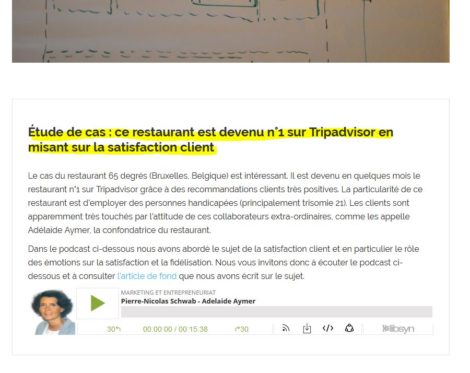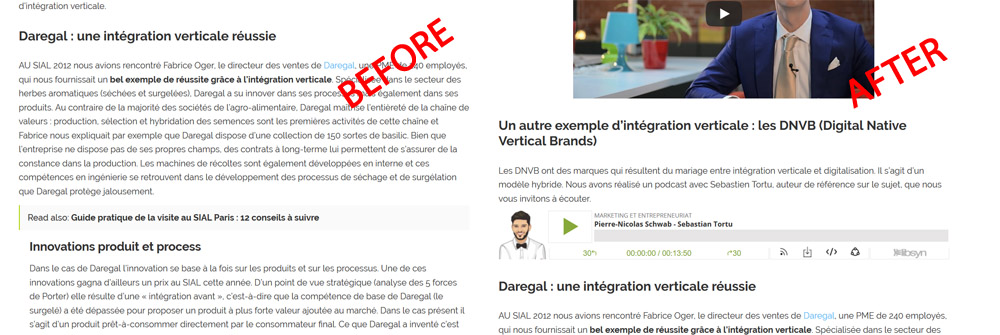
Updating your website is essential to improve its SEO. But how can you do it when you don’t have much time? In this article, I explain my method to update your content quickly while decreasing the rebound rate and increasing the time spent on your pages.
I know, it sounds too good to be true. But if I’ve made it into an article, it’s true, and it works—the word of a blogger and the word of an SEO enthusiast.
Summary
- Updating content and the impact on SEO
- My method: recycling podcasts
- Mix the formats for a better performance
- Disadvantages
- Conclusion
- The opinion of the SEO experts on my method

Updating old content: the best way to boost your SEO
What I’m about to say is entirely empirical, but since I have been taking the time to update my content, the performance of our entire site is increasing; and not just a little! +17% in French and up to +68% in English (read this article for more information).
I had additional metadata added in my WordPress interface: the updated date. And we made sure that this metadata is sent to Google.
The problem is that when you have more than 3000 articles like me on your site, updating them requires almost a full time. And as I try to manage by compressing costs, I had to find solutions. This is what I have done.
Content recycling: the most efficient way to do it
 Since December 2019, I publish once a week a podcast on a specific topic. Marketing, artificial intelligence, innovation, start-up everything goes as long as the guest is impressive, if possible well-known, and wants to share his business experience. So, I use these podcasts to update my old content. I write a small text of about a hundred words describing the podcast, I insert the player, I put the whole thing in an insert, and I paste the HTML code in all the articles related to the subject of the podcast. This is what it looks like in practice.
Since December 2019, I publish once a week a podcast on a specific topic. Marketing, artificial intelligence, innovation, start-up everything goes as long as the guest is impressive, if possible well-known, and wants to share his business experience. So, I use these podcasts to update my old content. I write a small text of about a hundred words describing the podcast, I insert the player, I put the whole thing in an insert, and I paste the HTML code in all the articles related to the subject of the podcast. This is what it looks like in practice.
As you can see, I’ve separated the podcast from the rest of the article. I also made sure that the link between the podcast and the article in which it is inserted is obvious.

Mix formats for improved performance
The method described below allows you to mix two content formats: text and audio. A user who likes your article will, therefore, have a particular interest in prolonging the experience and delving deeper into the subject by listening to the podcast. You see me coming, don’t you? Listening to a podcast takes more time than browsing an article diagonally. The time spent on the page increases, and so does your performance.
The combination of different formats is, therefore, an ideal solution for those who want to improve their SEO. Not only do you update your content (Google loves it) but you also offer value-added content to the users that your content interests.

The downsides of this method
Of course, no method to improve your SEO is perfect. This one is no exception.
I see two major drawbacks:
Podcasts: content that is expensive to produce
There’s no point in denying it. Even if you’re cutting the costs, podcasting is still a more expensive format to produce than text. You need a voice-over, credits, material, someone to help you edit the files. The costs quickly amount to 75€ per podcast. If you want to know all about my tips and tricks to produce low-cost podcasts, I recommend this article.
The language problem
The problem of language also arises for those who, like me, maintain a site in several languages. The podcast is made in only one language, and therefore only one version of your page can be updated in this way. The solution is, thus to create reference podcasts on specific topics in each language. You will, therefore, need to find 3 different people to develop the reference podcasts that you will need to update your site easily… or find someone who speaks several languages perfectly.
Conclusion
In this article, I presented my method to update my on-line content with a view to SEO optimisation. I use podcasts to create inserts that I then paste into all the articles, linking them to the subject matter. In doing so, I create relevant content and encourage visitors to listen to the podcast, which increases the time spent on the page.
Two drawbacks have been identified: the cost of creating podcasts on the one hand, and the need to create podcasts in as many languages as the pages you want to update.
The feedback of SEO experts
Before the publication of this article, I asked several experts to carefully reread it. I would like to thank all those who were willing to take part.
 The feedback of David Groult, SEO consultant in Lille.
The feedback of David Groult, SEO consultant in Lille.
In SEO, stability has always been essential for the management of your URLs. We can never recommend it enough; you should avoid modifying your URLs as much as possible. On the other hand, the truth is quite different when it comes to the content of a page. Google likes freshness. It is, therefore, essential to provide regularly updated content. This is especially true when you report structured data (microdata) that provides Google with the date the article was updated. Sometimes for older articles, updating this date (without necessarily modifying the content) will be enough to gain you a few SEO positions. Another idea to regularly update the content: make the article come alive with comments from Internet users. UGC content (User Generated Content) is also a good signal sent to Google and allows you to vary the semantics with the use of a different vocabulary. For this, it can always be interesting to propose as a conclusion, a question that leads to the discussion.
 The advice of Hubert de Cartier, Partner at Universem
The advice of Hubert de Cartier, Partner at Universem
When you write articles for your blog, taking the time to update them can be an essential source of additional organic traffic. To identify the content to be optimised, don’t hesitate to consult your Web Analytics solution to :
- Find articles that have brought organic traffic in the past and that no longer bring the same number of visits.
- Conversely, analyse articles that have delivered little traffic and deserve more visibility.
In both cases, remember to update according to the news, the latest trends, while having a different angle of attack at the semantic level if necessary. Adding other formats such as podcasts, infographics or videos will also be a plus to meet the increasingly varied needs of consumers and maximise its chances of increasing its visibility in search engines. It is also necessary to have an explicit mention of the original date of creation of the article and its update for the readers.
 The advice of Simon-Pierre Breuls, Partner at Universem
The advice of Simon-Pierre Breuls, Partner at Universem
The article highlights several essential elements for good SEO. Firstly, the content must be relevant and regularly updated to satisfy the Internet user who is looking for quality information. Secondly, internal link building is often a criterion that is not commonly used in the optimisation of your site, but a real internal link building strategy can boost your SEO. Small precision, the criterion like the bounce rate and the time spent on the site are not taken into account for the positioning of a web page in the SERP. But these two criteria are essential for the engagement of your audience and ultimately a conversion rate that will be better.
Illustration images: Shutterstock


